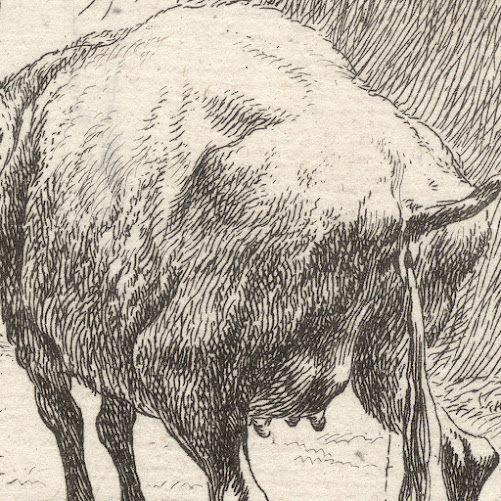Nicolaes Berchem (aka Nicolaes Pietersz. Berchem;
Nicolaes Berchen; Niclas Berghem; Claes Berighem; Nicolaes
Pietersz.Berrighem) (1624–1683)
“Pissing Ewe and a Sheep” (aka “Une brébis qui pisse” [Bartsch title]; “Pissende ooi en een schaap” [RIJKS title), c1650 (RIJKS: 1646–1652), plate 6 from the series of 8 plates, “Animalia” (aka “Animals”; “Schapen”; “Animalia ad vivum delineata et aqua forti aeri impressa Studio et Arte Nicolai Berchemi”; A Woman’s Sketchbook II [TIB title]).
Etching on laid paper trimmed around the platemark with chipped corners and backed with a support sheet.
Size: (sheet) 10.3 x 11.3 cm
State iii (of viii) Lifetime impression before the addition of the plate number
of state iv, but with more refining marks around the stone (compare to the
state ii impression held by the Rijksmuseum).
TIB 7(5).46(277) (Otto Naumann 1978, “The Illustrated Bartsch: Netherlandish Artists”, vol. 7, New York, Abaris Books, p. 76, cat. no. 46 [ 277]); Bartsch 277.46; Weigel 301.46; Dutuit I.45.46.I; Hollstein Dutch 46; Biesboer P82 (Pieter Biesboer et al. [eds.] 2006, “Nicolaes Berchem: in het licht van Italië”, Haarlem, Frans Hals Museum Ludion, pp. 124–25, 155, cat. no. P82).
The British Museum offers the following description of this print:
“Two sheep, one pissing seen from the back to the right, another one seen from the back in the left background … from a series of eight plates showing sheep Etching” (https://www.britishmuseum.org/collection/object/P_Sheepshanks-3968).
See also the description of this print offered by the Rijksmuseum:
http://hdl.handle.net/10934/RM0001.COLLECT.38088.
Condition: a strong and well-printed impression showing no sign of wear to the printing plate, trimmed around the platemark with chipped corners and laid onto a sheet of archival (millennium quality) washi paper. Beyond the losses at the corners, the sheet is in a good condition with no significant stains or foxing.
I am selling this remarkably unapologetic view of a ewe passing water—mindful that there was considerable interest by artists in the Dutch Golden Age for showing earthy views of everyday life—for the total cost of AU$198 (currently US$145.12/EUR122.69/GBP105.21 at the time of posting this listing) including postage and handling to anywhere in the world (but not, of course, any import duties/taxes imposed by some countries).
If you are interested in purchasing this visually arresting etching revealing not only the artist’s deep understanding of sheep, but also his acute observation and skill in showing the varying densities and degrees of transparency in a stream of urine—note in particular the subtle representation of the ewe’s further away leg seen through the urine—please contact me (oz_jim@printsandprinciples.com) and I will send you a PayPal invoice to make the payment easy.






















































